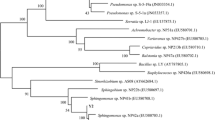Abstract
We have isolated a poly(vinyl alcohol) (PVA)-degrading bacterium from an activated sludge sample obtained from the drainage of a dyeing factory. Enrichment cultures were performed in media containing PVA as the sole or major carbon source. After several rounds of cultivation on liquid and solid media, we were able to isolate a single colony with PVA-degrading ability (strain PVA3). The bacterium could degrade PVA in the absence of symbionts or cofactors such as pyrroloquinoline quinone (PQQ). Over 90% of PVA, at an initial concentration of 0.1%, was degraded within a 6-day cultivation. Degradation was confirmed by both iodometric methods and gel permeation chromatography. Examination of the PVA attached to the cells revealed a large increase in carbonyl groups, suggesting the oxidation of hydroxyl groups of the polymer on the surfaces of cells. Addition of PQQ to the culture medium did not enhance the growth and the PVA-degrading rates of strain PVA3. Furthermore, we found that cells grown on PVA generated hydrogen peroxide upon the addition of PVA. The results strongly suggest that the initial oxidation of PVA is mediated via a PVA oxidase, and not a PQQ-dependent dehydrogenase. A biochemical and phylogenetic characterization of the bacterium was performed. The sequence of the 16S ribosomal RNA gene of the bacterium indicated a phylogenetic position of the strain within the genus Sphingopyxis, and the strain was therefore designated Sphingopyxis sp. PVA3.




Similar content being viewed by others
References
Finley JH (1961) Spectrophotometric determination of polyvinyl alcohol in paper coatings. Anal Chem 33:1925–1927
Fredrickson JK, Balkwill DL, Drake GR, Romine MF, Ringelberg DB, White DC (1995) Aromatic-degrading Sphingomonas isolates from the deep subsurface. Appl Environ Microbiol 61:1917–1922
Fukae R, Nakata K, Takeo M, Yamamoto T, Sangen O (2000) Biodegradation of PVAs with various stereoregularities. Sen’I Gakkaishi 56:254–258
Godoy FA, Bunster M, Matus V, Aranda C, González B, Martínez MA (2003) Poly-β-hydroxyalkanoates consumption during degradation of 2,4,6-trichlorophenol by Sphingopyxis chilensis S37. Lett Appl Microbiol 36:315–320
Hashimoto S, Fujita M (1985) Isolation of a bacterium requiring three amino acids for polyvinyl alcohol degradation. J Ferment Technol 63:471–474
Kim BC, Sohn CK, Lim SK, Lee JW, Park W (2003) Degradation of polyvinyl alcohol by Sphingomonas sp. SA3 and its symbiote. J Ind Microbiol Biotechnol 30:70–74
Matsumura S, Shimura Y, Terayama K, Kiyohara T (1994) Effects of molecular weight and stereoregularity on biodegradation of poly(vinyl alcohol) by Alcaligenes faecalis. Biotechnol Lett 16:1205–1210
Mori T, Sakimoto M, Kagi T, Sakai T (1996) Isolation and characterization of a strain of Bacillus megaterium that degrades poly(vinyl alcohol). Biosci Biotechnol Biochem 60:330–332
Morita M, Hamada N, Sakai K, Watanabe Y (1979) Purification and properties of secondary alcohol oxidase from a strain of Pseudomonas. Agric Biol Chem 43:1225–1235
Qian D, Du G, Chen J (2004) Isolation and culture characterization of a new polyvinyl alcohol-degrading strain: Penicillium sp. WSH02-21. World J Microbiol Biotechnol 20:587–591
Saitou N, Nei M (1987) The neighbor-joining method—a new method for reconstructing phylogenetic trees. Mol Biol Evol 4:406–425
Sakai K, Hamada N, Watanabe Y (1985a) Purification and properties of oxidized poly(vinyl alcohol) hydrolase with an acidic isoelectric point. Agric Biol Chem 49:827–833
Sakai K, Hamada N, Watanabe Y (1985b) Purification and properties of secondary alcohol oxidase with an acidic isoelectric point. Agric Biol Chem 49:817–825
Sakazawa C, Shimao M, Taniguchi Y, Kato N (1981) Symbiotic utilization of polyvinyl alcohol by mixed cultures. Appl Environ Microbiol 41:261–267
Shimao M (2001) Biodegradation of plastics. Curr Opin Biotechnol 12:242–247
Shimao M, Taniguchi Y, Shikata S, Kato N, Sakazawa C (1982) Production of polyvinyl alcohol oxidase by a symbiotic mixed culture. Appl Environ Microbiol 44:28–32
Shimao M, Ninomiya K, Kuno O, Kato N, Sakazawa C (1986) Existence of a novel enzyme, pyrroloquinoline quinone-dependent polyvinyl alcohol dehydrogenase, in a bacterial symbiont, Pseudomonas sp. strain VM15C. Appl Environ Microbiol 51:268–275
Suzuki T, Ichihara Y, Yamada M, Tonomura K (1973) Some characteristics of Pseudomonas O-3 which utilizes polyvinyl alcohol. Agric Biol Chem 37:747–756
Thompson JD, Higgins DG, Gibson TJ (1994) Clustal-W—improving the sensitivity of progressive multiple sequence alignment through sequence weighting, position-specific gap penalties and weight matrix choice. Nucleic Acids Res 22:4673–4680
Tokiwa Y, Fan H, Hiraguri Y, Kurane R, Kitagawa M, Shibatani S, Maekawa Y (2000) Biodegradation of a sugar branched polymer consisting of sugar, fatty acid, and poly(vinyl alcohol). Macromolecules 33:1636–1639
Tokiwa Y, Kawabata G, Jarerat A (2001) A modified method for isolating poly(vinyl alcohol)-degrading bacteria and study of their degradation patterns. Biotechnol Lett 23:1937–1941
Author information
Authors and Affiliations
Corresponding author
Rights and permissions
About this article
Cite this article
Yamatsu, A., Matsumi, R., Atomi, H. et al. Isolation and characterization of a novel poly(vinyl alcohol)-degrading bacterium, Sphingopyxis sp. PVA3. Appl Microbiol Biotechnol 72, 804–811 (2006). https://doi.org/10.1007/s00253-006-0351-4
Received:
Revised:
Accepted:
Published:
Issue Date:
DOI: https://doi.org/10.1007/s00253-006-0351-4




